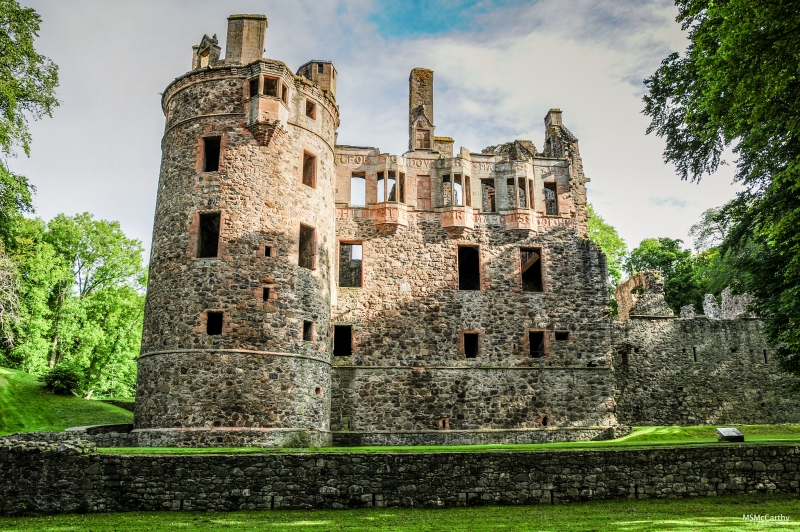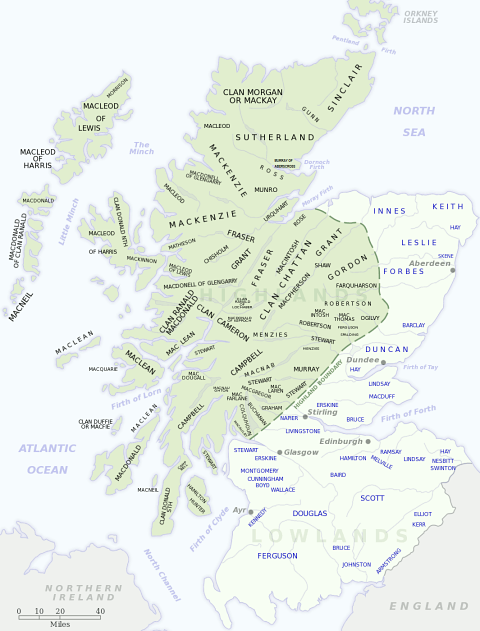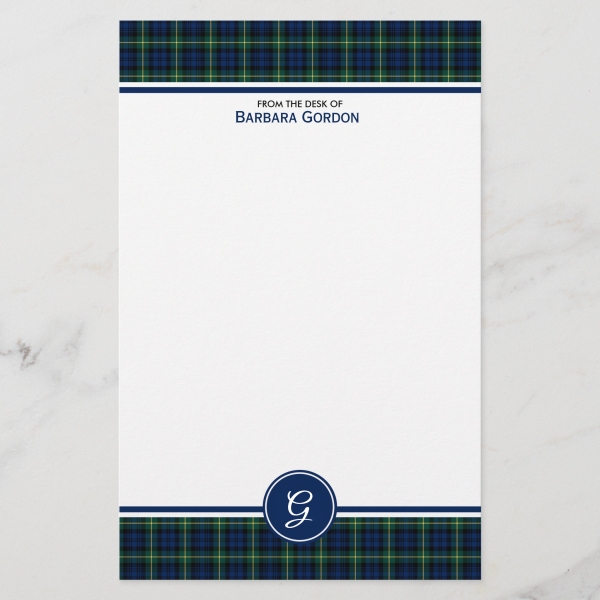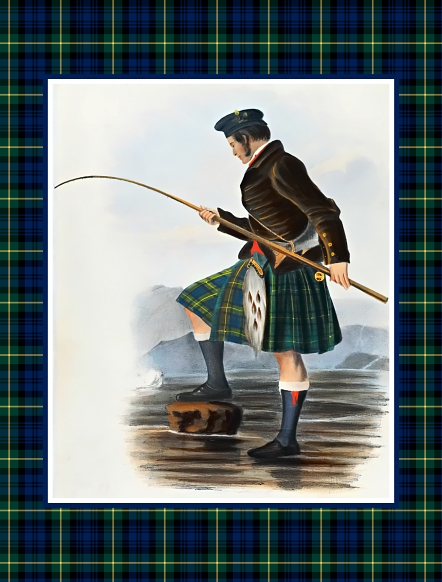
Motto: Animo non Astutia (By courage, not by craft)
Historic Seat: Huntly Castle
District: Aberdeenshire
Associated Surnames: Addison, Adie, Aitcheson, Aitken, Barrie, Cullen, Eadie, Geddes, Huntly, Mavor, Milne, Todd
Associated Tartans:
Early Gordon Genealogy and History:
(Excerpt from "The Scottish Clans and Their Tartans", James Grant, 1906)
The first Gordon of whom there is any distinct trace is Richard of Gordon, said to be the grandson of a famous knight who slew some monstrous animal in the Merse in the time of Malcolm III.
That Richard was Lord of the Barony of Gordon in the Merse is undoubted as between 1150 and 1160 he granted from that estate a piece of land to monks of St Mary at Kelso, a grant confirmed by his son, Thomas. Other Gordons figure in history about this time, apart from Bertram de Gordon, whose arrow in 1199 wounded Richard of England at Chalons.
Alicia IV of the Gordon family, an heiress, married her cousin, Adam Gordon, who was a soldier among the 1000 auxiliaries whom Alexander III sent with Louis of France to Palestine, where he was slain. From his grandson, Sir Adam, all the Gordons in Scotland are descended, says Douglas; and the first appearance he makes in history was the assistance he gave Wallace in 1297 to recapture the Castle of Wigton, of which was made Governor. For his many faithful services, Robert I, on the forfeiture of David, Earl of Thole, gave him a charter of the lands of Strathbogie (or Huntly.) He was killed at Halidon Hill1; but his son, Sir Alexander, escaped the slaughter, and was the first designed of Huntly.
Sir Adam Gordon, in descent tenth of Gordon and Huntly, whose father was slain at Otterburn2 lost his life fighting for his country at the battle of Homildon3 in 1402, leaving only a daughter, who married a second son of Seton of that Ilk. Their eldest son, Alexander, assumed the name of Gordon, and, in consequence of his great public services to James I and James II, he was in 1445 created by the latter Earl of Huntly, and died some twenty years after at a very great age.
To trace all the great actions and deeds of the warlike line of Huntly would far exceed our space.
Alexander, third Earl, fought at Flodden4; George, fourth Earl, was general of the forces on the Borders to oppose those of Henry VIII under Norfolk, with whom he had many victorious encounters; but in an attempt to get the Queen out of the hands of the Earl of Moray, he was attacked by the MacKenzies, Munroes, Frasers, and MacIntoshes at Corrichie5, where he was slain in 1562.
George, sixth Earl of Huntly, whose father had been High Chancellor, with other Catholic nobles, was suspected of having a secret correspondence with the Spaniards, and troops were sent against them by James VI in 1594. The latter were defeated, but Huntly was pardoned, appointed Lieutenant of the North, and created a Marquis in 1599.
George, the second Marquis, was Captain of the Scottish Guard of Louis XIII and was so strongly attached to the cause of Charles I that he was forfeited by the Scottish Parliament in 1645, and his property seized. He lost his head for his loyalty at Edinburgh in 1649. Four years before this his eldest son perished in the Royal cause at the battle of Alford6. Goerge, fourth Marquis, was created a Duke, 1684, and his noble defence of the Castle of Edinburgh for James VII is a stirring event in Scottish history.
On the death of George, fifth Duke, in 1836, the title became extinct, but the Marquisate of Huntly went to the Earl of Aboyne, lineally descended from Charles, fourth son of George, second Marquis of Huntly, who was raised to the Peerage of Aboyne by Charles II for his many loyal services.
The fighting force of the clan, when in arms for King James in 1715, is given by General Wade at 1000 claymores.
The Earls of Aberdeen, so created in 1682, are descended from Patrick Gordon of Methlic (cousin of the Earl of Huntly), who fell at the battle of Arbroath7 in 1445. They were afterwards designed as the Lairds of Methlic and Haddo.
Ten gentlemen of this clan were created Baronets, viz., Gordon of Gordounstoun, Gordon of Cluny, and Gordon of Lismore in 1625; Gordon of Lochinvar, 1626; Gordon of Park, 1686; Gordon of Dalpholly, 1704; Gordon of Earlstoun, 1706; Gordon of Embo, 1631; Gordon of Halkin (by succession), 1813; Gordon of Niton, 1818.
Two regiments, named the "Gordon Highlanders" have been raised from this clan. The first of these was the old "81st", formed in 1777 by Hon. Colonel William Gordon, son of the Earl of Aberdeen, and disbanded in 1783. The second was the "92nd" or "Gordon Highlanders," raised by the Marquis of Huntly in 1794, memorable for its high valour in every war since then. When the system of linked battalions was instituted, the old 75th and 92nd became the Gordon Highlanders, and it is the former who are the heroes of Dargai.
(End excerpt)
Next page: Clan Graham
Footnotes:
1 The Battle of Halidon Hill (1333): The Battle of Halidon Hill was fought on 19 July 1333 during the Second War of Scottish Independence between Scottish forces led by Sir Archibald Douglas and the English forces of King Edward III of England, near Berwick, a disputed territory in the borderlands between England and Scotland. Read more about the Battle of Halidon Hill at Wikipedia.
2 The Battle of Otterburn (1388): The Battle of Otterburn was fought in August 1388 (conflicting sources state both the 5 August and the 19 of August) in Northumberland, England. It was fought between invading Scots, led by James, 2nd Earl of Douglas, and the border forces of England. Read more about the Battle of Otterburn at Wikipedia.
3 The Battle of Homildon Hill (1402): A conflict between the English, under Henry Percy, 1st Earl of Northumberland, and the Scots, under Archibald Douglas, 4th Earl of Douglas, on 14 September 1402 in Northumberland, England. Read more about the Battle of Homildon Hill at Wikipedia.
4 The Battle of Flodden (1513): The Battle of Flodden Field was fought on 9 September 1513, in Northumberland England between an army of Scots under King James IV and an English army commanded by the Earl of Surrey. Read more about the Battle of Flodden at Wikipedia.
5 The Battle of Corrichie (1562): The Battle of Corrichie, was fought near Meikle Tap, near Aberdeen, Scotland on 28 October 1562, between the forces of George Gordon, 4th Earl of Huntly and chief of Clan Gordon, against the forces of Mary, Queen of Scots, led by James Stewart, 1st Earl of Moray. It was fought due to George Gordon having lost the earldom of Moray, which he considered his heritage, to Mary Queen of Scots' half-brother. Read more about the Battle of Corrichie at Wikipedia.
6 The Battle of Alford (1645): The Battle of Alford took place near the village of Alford, Aberdeenshire, on 2 July 1645, and was fought between Royalist forces led by James Graham, Marquess of Montrose, and forces of the Covenanter-dominated Scottish government commanded by William Baillie. This battle was fought primarily to tie up government troops that would otherwise been used in fighting the English Civil War. Read more about the Battle of Alford at Wikpedia.
7 The Battle of Arbroath (1445): The Battle of Arbroath was fought on 24 January 1445 at Arbroath, in Perthshire, Scotland. It was between rival claimants to the post of Baillie of the Regality, a position charged with dispensing justice throughout the jurisdiction of the monastery. Read more about the Battle of Arbroath at Wikipedia.

Distribution of Scottish clans and families
View larger map at Wikimedia Commons

Browse the Clan Gordon Tartan Collection with home decor, personal accessories, crafting, paper products, and more.

Browse the Clan Gordon Dress Tartan Collection with home decor, personal accessories, crafting, paper products, and more.

Clan Gordon Postcard: Digitally cleaned and enhanced vintage illustration with tartan border.